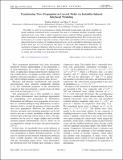Transforming Wave Propagation in Layered Media via Instability-Induced Interfacial Wrinkling
Author(s)
Rudykh, Stephan; Boyce, Mary Cunningham
DownloadRudykh-2014-Transforming Wave Propagation.pdf (687.3Kb)
PUBLISHER_POLICY
Publisher Policy
Article is made available in accordance with the publisher's policy and may be subject to US copyright law. Please refer to the publisher's site for terms of use.
Terms of use
Metadata
Show full item recordAbstract
The ability to control wave propagation in highly deformable layered media with elastic instability-induced wrinkling of interfacial layers is presented. The onset of a wrinkling instability in initially straight interfacial layers occurs when a critical compressive strain is achieved. Further compression beyond the critical strain leads to an increase in the wrinkle amplitude of the interfacial layer. This, in turn, gives rise to the formation of a system of periodic scatterers, which reflect and interfere with wave propagation. We demonstrate that the topology of wrinkling interfacial layers can be controlled by deformation and used to produce band gaps in wave propagation and, hence, to selectively filter frequencies. Remarkably, the mechanism of frequency filtering is effective even for composites with similar or identical densities, such as polymer-polymer composites. Since the microstructure change is reversible, the mechanism can be used for tuning and controlling wave propagation by deformation.
Date issued
2014-01Department
Massachusetts Institute of Technology. Department of Mechanical EngineeringJournal
Physical Review Letters
Publisher
American Physical Society
Citation
Rudykh, Stephan, and Mary C. Boyce. “Transforming Wave Propagation in Layered Media via Instability-Induced Interfacial Wrinkling.” Physical Review Letters 112, no. 3 (January 2014). © 2014 American Physical Society
Version: Final published version
ISSN
0031-9007
1079-7114